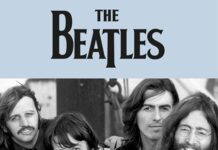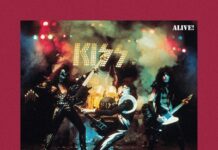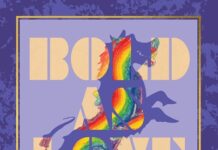The first time I dropped the needle on The White Album it was Christmas Day, 1968. The double album came out the month before, though I was too young to notice. Then my parents surprised me with a stereo from JCPenney and two albums they were told were “cool” — The Doors’ Waiting for The Sun and The White Album. With these records in my collection, I put away the 45s and Chipmunks records, and started a lifelong obsession with album-oriented rock, or AOR as it’s known to hip insiders.
I dug the Doors, but the Beatles were my “it” band and I played The White Album literally to pieces. The poster that came with the set fell apart from repeated foldings, and the record cover tore so badly it could no longer house the two Apple vinyl records. The only thing still intact were the four individual colored portraits of John Lennon, Paul McCartney, George Harrison and Ringo Starr that I later stashed away for good keeping. My first copy of The White Album was eventually left for dead, discarded and replaced with the 8-track, then a mid 70s Capitol vinyl reissue. Years later, it dawned on me that I should have kept my original Apple version.
When CDs came along in the 80s, I picked up the initial release , then the 30th anniversary version, then the 2009 remastered version. And now, for its 50th anniversary, The White Album has been remixed in a variety of sonic flavors, and made available in several different formats and configurations. For the Beatles fanatic with deep pockets, the Super Deluxe set answers all your prayers. The seven-disc collection includes the 2018 stereo album mix on two CDs.
A third CD has the famed Esher Demos — 27 loose, mostly acoustic takes of songs that would eventually land on The White Album, as well as subsequent Beatles and solo albums, all recorded at George Harrison’s house. For many, a recording of this warm and friendly gathering featuring these early Lennon, McCartney and Harrison songs written during the Beatles’ time in India is the holy grail.
Three more CDs comprise 50 tracks, mostly unreleased, from studio sessions for The White Album. While bits and pieces of the outtakes, different arrangements, and impromptu, extended jams have surfaced over the years on numerous bootlegs and the three-volume Anthology releases of the mid 90s, nothing comes close to what’s here — pristine and historical blueprints from arguably the Beatles’ most pivotal album — wherein the group traded their collective mop top image for a more narrowed focus on the parts of the sum. Even so, most every track has all four Beatles. Without giving away too much, you’ll never want to hear the original “Cry Baby Cry” after you hear the other version here.
For audiophiles, the Blu-ray brings mono, stereo and surround mixes of The White Album to life. During a playback of the new mixes for members of the press at Capitol Records, I asked Giles Martin, who oversaw the mixes and reissue, about the surround mixes, and he said with a smirk: “‘Revolution 9’ is scary.” Depending on your sound system, that could very well be true. Fortunately, the purists who despise tampering too much with the original mixes have the mono to feast on. All it comes together in a “slip-sleeved” 164-page hardbound book, with reproductions of the four individual colored portraits I have, plus the poster, which should remained folded if you know what’s good for you.
Fifty years later, it’s still possible to discover new and wondrous things about The White Album. As the Beatles’ first release on their own Apple Records label, the record’s four sides are an abundance of acute songwriting, blooming with musically profound possibilities, streaming from four asymmetrical personalities blended into a joyous cornucopia of hedonistic rapture for the mind, body and spirit. For an impressionable youngster with an ear for a melody, it was a divergence of ideas with a powerful tempo from the get-go — the dust settles after the uproar of “Back In The U.S.S.R.,” allowing “Dear Prudence” to rise and majestically sprinkle a bright and fluid guitar progression around Lennon’s haunting vocals. And at once, the listener is pulled into a parade of heady concepts with all-encompassing titles like “Glass Onion,” “The Continuing Story of Bungalow Bill” (featuring a non-credited vocal from Yoko Ono), “While My Guitar Gently Weeps” (featuring a non-credited guitar solo from Eric Clapton), and the sardonically wicked “Happiness Is A Warm Gun.”
Side two (if you owned the vinyl) has McCartney singing to his dog on “Martha My Dear” and Lennon singing to his mother on “Julia.” It also finds Harrison rolling in the mud with the delightful “Piggies” and Starr debuting his first songwriting contribution to a Beatles record with the country-flavored “Don’t Pass Me By.” Not even throwaway fillers like “Wild Honey Pie” and “Why Don’t We Do It In The Road?” could deter a young man’s affection for the first record of The White Album set. The second record (AKA sides three and four) is another thing altogether.
George Martin suggested in an interview that The White Album might have been better suited as a single album. Tracking through the second record, it’s easy to see how it could have very well stood on its own. When you have the all-in sway of “Birthday,” today a standard any bar band has in its repertoire for those special occasions, slotted in as the ice-breaker, the expectancy of what’s to follow is hanging in the balance. “Yer Blues” lets Lennon howl raw and emotively enough to make a solid case, before he takes veiled hits at Maharishi Mahesh Yogi on the swinging “Everybody’s Got Something To Hide Except Me And My Monkey” and equally alluring “Sexy Sadie.” What else could McCartney do but reply with the utter recklessness of “Helter Skelter” (Spoiler alert: the 27-minute version of “Helter Skelter” didn’t make the cut on the Super Deluxe set due to space constraints, but there’s a loose and lumpy 13-minute run-through on there).
The fourth and final side of The White Album is where the record’s greatest extremes coalesce in a polite poke in the ear drum. Depending on your mood, the easy-going and casual drive of “Revolution I” might make you appreciate the edgier, harder arrangement of the “Revolution” single that came out five months before The White Album a little more. McCartney’s “Honey Pie” is a camp-filled romp in the style of “When I’m 64,” while “Savoy Truffle” and “Cry Baby Cry” shine in execution and elegance. And, of course, as a sound collage, “Revolution 9” should sound scary in surround. Its place on The White Album has been hotly debated among fans and critics alike for years; it’s general disregard for form and harmony making it both disdainful and captivating. How it goes over at your next party really depends on who you invite.
By the end of 1968, which saw the sinister assassinations of both Martin Luther King, Jr. and Robert Kennedy, major upheavals in the Vietnam War, and Richard Nixon become President of the United States, the Beatles transcended the turbulence and delivered an album ripe with maturity, void of compromise, organically spun with heart, soul, and conviction. Celebrating The White Album, blemishes and all, a half-century later should remind us how integral and life-altering music from that time period was. For a wee lad like me, it was the beginning of something that would affect the rest of my life.




















